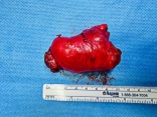Treatment of Angiomyoblastoma in a Young Lady in Saudi Arabia: A Case Report and Literature Review
DOI:
https://doi.org/10.31661/gmj.v14i.3861Keywords:
Angiomyofibroblastoma; Vagina; Treatment; Surgical Excision; Young LadyAbstract
Background: Angiomyofibroblastoma (AMFB) is a rare, benign soft tissue tumor that belongs to the mesenchymal tumor category and affects the female genital tract. Aggressive angiomyxoma, a distinct stroma myxoedematous mesenchymal tumor with a significant risk of local recurrences, must be histomorphologically distinguished from AMFB. Radiography and histopathology are used for accurate diagnosis. The treatment depended on the complete surgical excision.
Case presentation: Herein, we presented a case of a 36-year-old female (P3+0) presented with a left vaginal mass noted two years prior. The radiology report suggested angiomyxoma or myxoid liposarcoma as possible differentials. Surgical resection revealed a benign genital stromal tumor, specifically angiomyofibroblastoma (AMFB). After complete surgical excision, the immunohistochemical analysis supported the diagnosis of angiomyofibroblastoma. Two months postoperatively, an MRI Post-resection images show complete resection with no feasible scar, residual tumor, or recurrence.
Conclusion: Our case is rare AMFB. AMFB may be missed when diagnosed with other masses, such as angiomyxoma or myxoid liposarcoma, so we need to do the necessary tests to diagnose and differentiate AMFB accurately from other masses. Ultrasound and MRI are initial diagnostic tools, while histopathology ensures the correct diagnosis. Surgical removal with free margins remains the appropriate treatment. Long-term follow-up is essential to monitor for potential recurrence, though AMFB typically carries an excellent prognosis.
References
Fatusic J, Hudic I, Fatusic Z, Mustedanagic-Mujanovic J. Angiomyofibroblastoma of the vaginal portion. Med Arch. 2014;68(6):424-5.
https://doi.org/10.5455/medarh.2014.68.424-425
PMid:25648716 PMCid:PMC4314174
Sherif M, Mohamed I. Massive angiomyofibroblastoma of the glans penis. BMJ Case Rep. 2019;12(6):e229486.
https://doi.org/10.1136/bcr-2019-229486
PMid:31167770 PMCid:PMC6557419
Fletcher CD, Tsang WY, Fisher C, Lee KC, Chan JK. Angiomyofibroblastoma of the vulva: a benign neoplasm distinct from aggressive angiomyxoma. The American journal of surgical pathology. 1992 Apr 1;16(4):373-82.
https://doi.org/10.1097/00000478-199204000-00006
PMid:1314521
Kwack JY, Kim S, Lee JS, Kwon YS. Case Report of Vaginal Angiomyofibroblastoma and Differential Diagnosis of Other Benign Mesenchymal Tumors in the Female Genitalia. J. Clin Obstet Gynecol. 2024 Mar 1;34:36-40.
https://doi.org/10.5336/jcog.2023-97358
Nielsen GP, Rosenberg AE, Young RH, Dickersin GR, Clement PB, Scully RE. Angiomyofibroblastoma of the vulva and vagina. Modern pathology: an official journal of the United States and Canadian Academy of Pathology, Inc. 1996 Mar 1;9(3):284-91.
Sassi S, Nadim C, El Mohtarim R, Rouas L, Yousfi M, Lamalmi N, Hassouni FE. Angiomyofibroblastoma of the vulva: a case report and review of the literature. Case Reports in Women's Health. 2024 Jun 1;42:e00617.
https://doi.org/10.1016/j.crwh.2024.e00617
PMid:38827183 PMCid:PMC11141263
Sims SM, Stinson K, McLean FW, Davis JD, Wilkinson EJ. Angiomyofibroblastoma of the vulva: a case report of a pedunculated variant and literature review. Journal of Lower Genital Tract Disease. 2012 Apr 1;16(2):149-54.
https://doi.org/10.1097/LGT.0b013e318231217b
PMid:22371044
Seo JW, Lee KA, Yoon NR, Lee JW, Kim BG, Bae DS. Angiomyofibroblastoma of the vulva. Obstetrics & Gynecology Science. 2013 Sep 14;56(5):349.
https://doi.org/10.5468/ogs.2013.56.5.349
PMid:24328028 PMCid:PMC3784123
Laraqui Housseini Y, Elouazzani H, Housseini LL, Cherkaoui M, Zouaidia F. Pelvic angiomyofibroblastoma: an unusual case report. Journal of Surgical Case Reports. 2020 May;2020(5):rjaa051.
https://doi.org/10.1093/jscr/rjaa051
PMid:32477485 PMCid:PMC7246335
Menéndez-Sánchez P, Villarejo-Campos P, Padilla-Valverde D, Muñoz-Atienza V, González-López L, Martín-Fernández J. Angiomyofibroblastoma of the right ischiorectal fosa. Cirugía y Cirujanos. 2010;78(5):448-50.
Eckhardt S, Rolston R, Palmer S, Ozel B. Vaginal angiomyofibroblastoma: a case report and review of diagnostic imaging. Case Reports in Obstetrics and Gynecology. 2018;2018(1):7397121.
https://doi.org/10.1155/2018/7397121
PMid:30105110 PMCid:PMC6076939
Angelico G, Marletta S, Broggi G, Vigneri P, Vecchio GM, Salvatorelli L, Magro G. Practical approach to the diagnosis of the vulvovaginal stromal tumors: an overview. Diagnostics. 2022 Jan 31;12(2):357.
https://doi.org/10.3390/diagnostics12020357
PMid:35204448 PMCid:PMC8871080
McCluggage WG, White RG. Angiomyofibroblastoma of the vagina. Journal of Clinical Pathology. 2000 Oct 1;53(10):803-.
https://doi.org/10.1136/jcp.53.10.803
PMid:11064681 PMCid:PMC1731080

Published
How to Cite
Issue
Section
License
Copyright (c) 2025 Galen Medical Journal

This work is licensed under a Creative Commons Attribution 4.0 International License.







